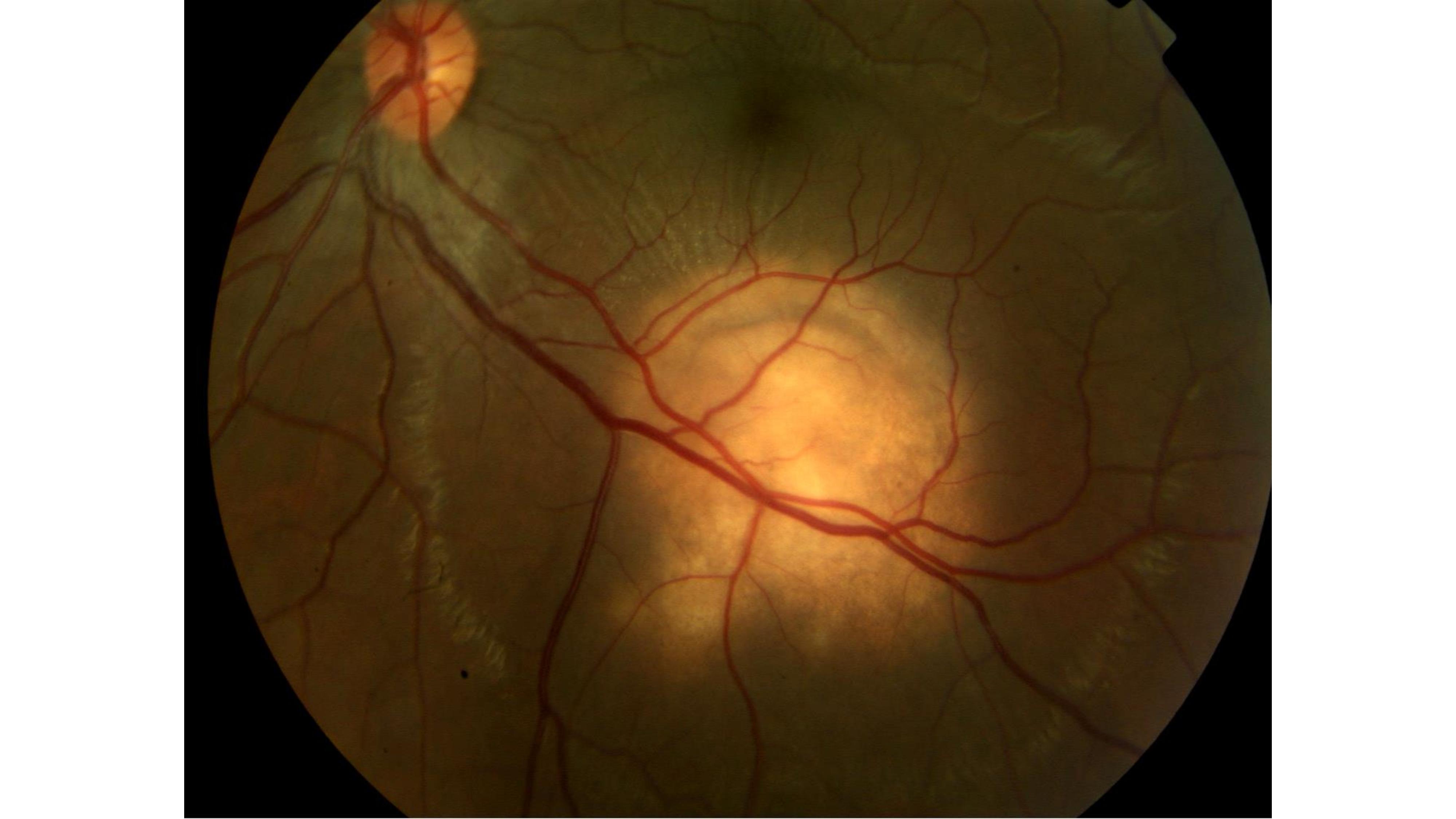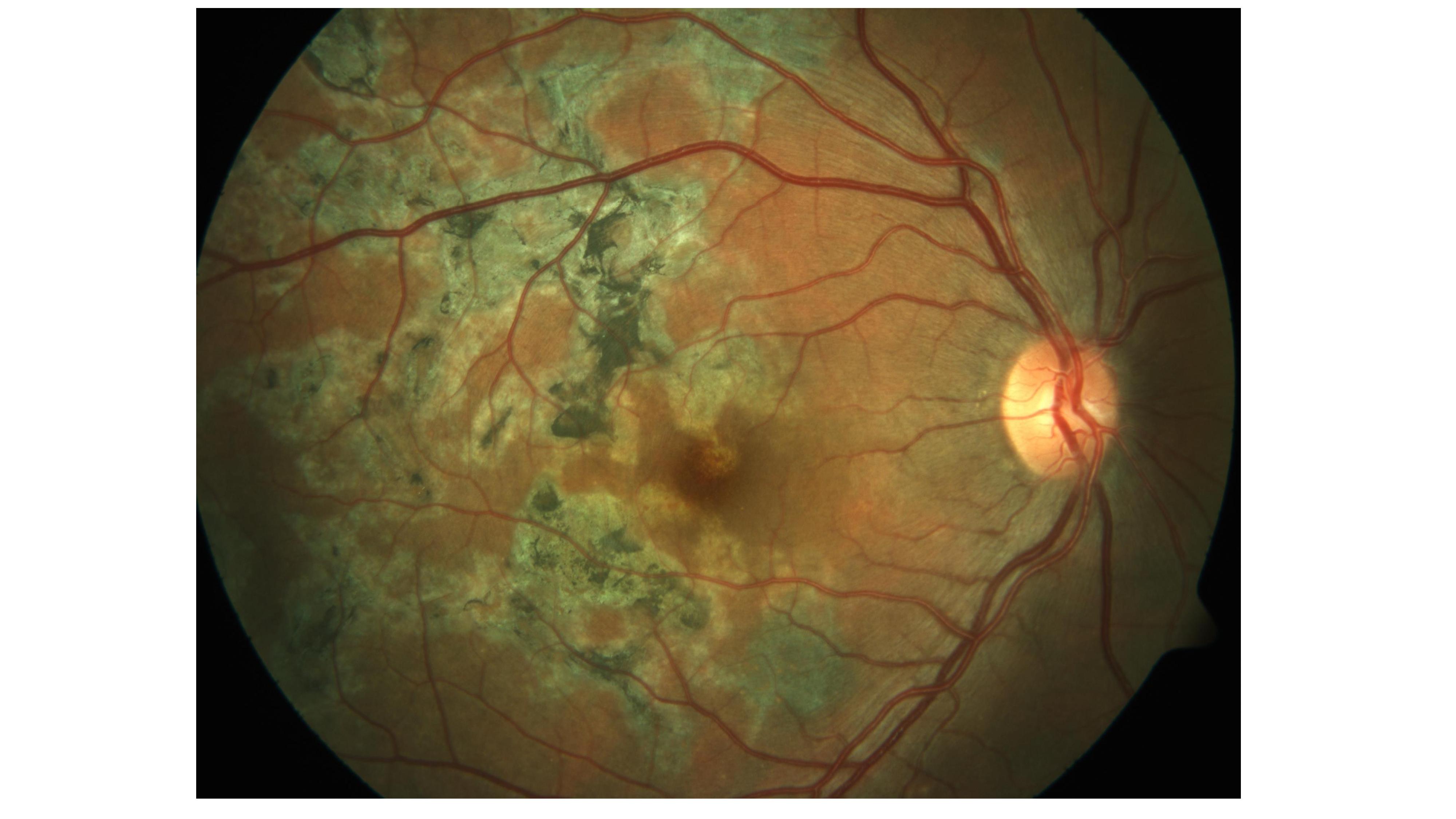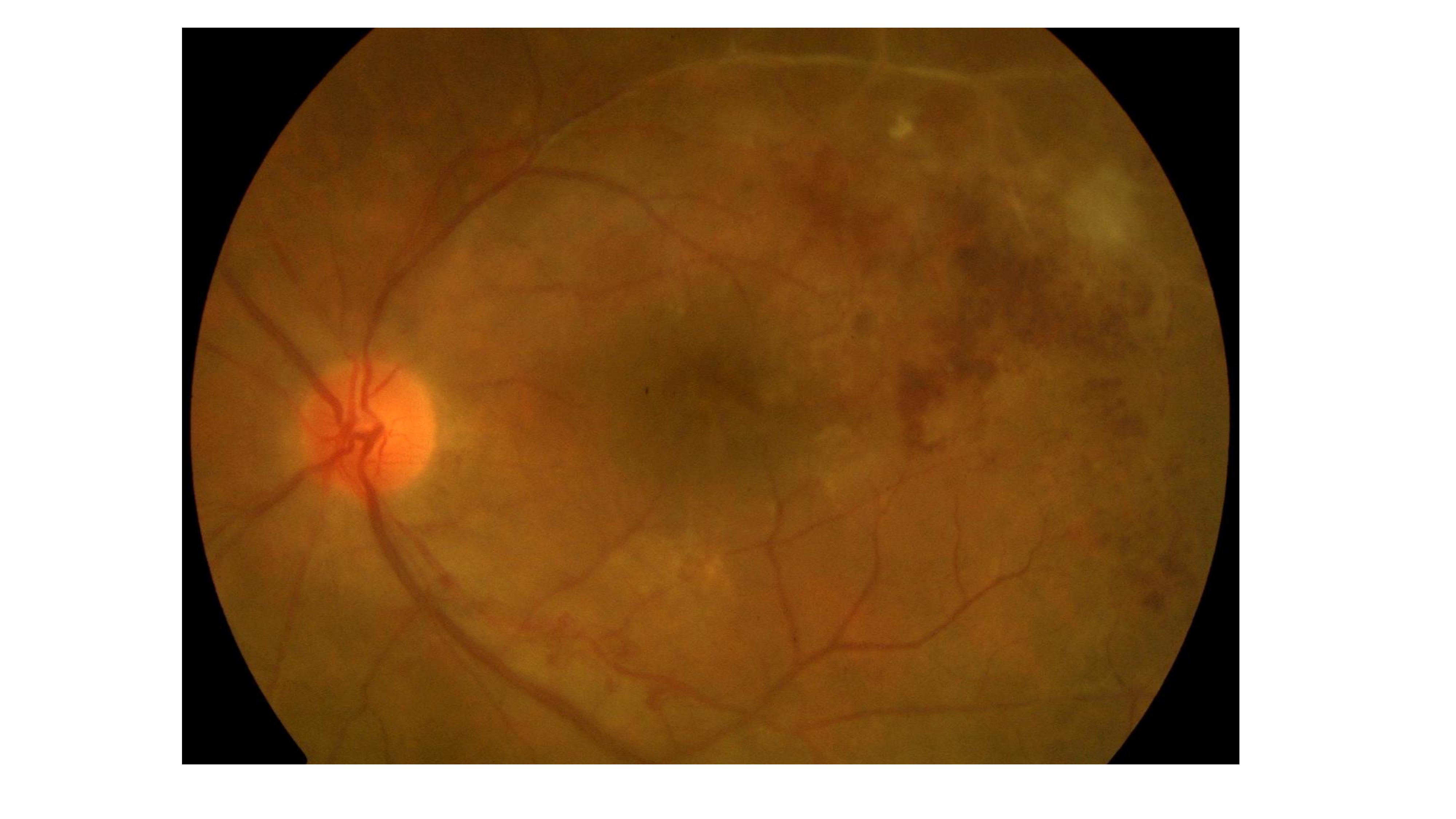[1]
Helm CJ,Holland GN, Ocular tuberculosis. Survey of ophthalmology. 1993 Nov-Dec;
[PubMed PMID: 8310395]
Level 3 (low-level) evidence
[2]
EMERY JL,LORBER J, Radiological and pathological correlation of miliary tuberculosis of lungs in children, with special reference to choroidal tubercles. British medical journal. 1950 Sep 23;
[PubMed PMID: 14772458]
[3]
MacNeil A,Glaziou P,Sismanidis C,Maloney S,Floyd K, Global Epidemiology of Tuberculosis and Progress Toward Achieving Global Targets - 2017. MMWR. Morbidity and mortality weekly report. 2019 Mar 22;
[PubMed PMID: 30897077]
[4]
Dannenberg AM Jr, Delayed-type hypersensitivity and cell-mediated immunity in the pathogenesis of tuberculosis. Immunology today. 1991 Jul;
[PubMed PMID: 1822092]
[5]
Krishnan N,Robertson BD,Thwaites G, The mechanisms and consequences of the extra-pulmonary dissemination of Mycobacterium tuberculosis. Tuberculosis (Edinburgh, Scotland). 2010 Nov;
[PubMed PMID: 20829117]
[6]
Bloom BR,Atun R,Cohen T,Dye C,Fraser H,Gomez GB,Knight G,Murray M,Nardell E,Rubin E,Salomon J,Vassall A,Volchenkov G,White R,Wilson D,Yadav P, Tuberculosis 2017 Nov 3;
[PubMed PMID: 30212088]
[7]
Alvarez GG,Roth VR,Hodge W, Ocular tuberculosis: diagnostic and treatment challenges. International journal of infectious diseases : IJID : official publication of the International Society for Infectious Diseases. 2009 Jul;
[PubMed PMID: 19386531]
[8]
Donahue HC, Ophthalmologic experience in a tuberculosis sanatorium. American journal of ophthalmology. 1967 Oct;
[PubMed PMID: 6061532]
[9]
Bouza E,Merino P,Muñoz P,Sanchez-Carrillo C,Yáñez J,Cortés C, Ocular tuberculosis. A prospective study in a general hospital. Medicine. 1997 Jan;
[PubMed PMID: 9064488]
[10]
Singh R,Gupta V,Gupta A, Pattern of uveitis in a referral eye clinic in north India. Indian journal of ophthalmology. 2004 Jun;
[PubMed PMID: 15283216]
[11]
Morimura Y,Okada AA,Kawahara S,Miyamoto Y,Kawai S,Hirakata A,Hida T, Tuberculin skin testing in uveitis patients and treatment of presumed intraocular tuberculosis in Japan. Ophthalmology. 2002 May;
[PubMed PMID: 11986087]
[12]
Pillai S,Malone TJ,Abad JC, Orbital tuberculosis. Ophthalmic plastic and reconstructive surgery. 1995 Mar;
[PubMed PMID: 7748819]
[13]
Heiden D,Saranchuk P,Keenan JD,Ford N,Lowinger A,Yen M,McCune J,Rao NA, Eye examination for early diagnosis of disseminated tuberculosis in patients with AIDS. The Lancet. Infectious diseases. 2016 Apr;
[PubMed PMID: 26907735]
[14]
Gupta V,Gupta A,Rao NA, Intraocular tuberculosis--an update. Survey of ophthalmology. 2007 Nov-Dec;
[PubMed PMID: 18029267]
Level 3 (low-level) evidence
[15]
Biswas J,Therese L,Madhavan HN, Use of polymerase chain reaction in detection of Mycobacterium tuberculosis complex DNA from vitreous sample of Eales' disease. The British journal of ophthalmology. 1999 Aug;
[PubMed PMID: 10413707]
[16]
Madhavan HN,Therese KL,Gunisha P,Jayanthi U,Biswas J, Polymerase chain reaction for detection of Mycobacterium tuberculosis in epiretinal membrane in Eales' disease. Investigative ophthalmology
[PubMed PMID: 10711699]
[17]
Golden MP,Vikram HR, Extrapulmonary tuberculosis: an overview. American family physician. 2005 Nov 1;
[PubMed PMID: 16300038]
Level 3 (low-level) evidence
[18]
Khan FY, Review of literature on disseminated tuberculosis with emphasis on the focused diagnostic workup. Journal of family
[PubMed PMID: 31143078]
[20]
Thomas S,Suhas S,Pai KM,Raghu AR, Lupus vulgaris--report of a case with facial involvement. British dental journal. 2005 Feb 12;
[PubMed PMID: 15706374]
Level 3 (low-level) evidence
[21]
Madhukar K,Bhide M,Prasad CE,Venkatramayya, Tuberculosis of the lacrimal gland. The Journal of tropical medicine and hygiene. 1991 Jun;
[PubMed PMID: 2051518]
[22]
Gupta A,Gupta V,Arora S,Dogra MR,Bambery P, PCR-positive tubercular retinal vasculitis: clinical characteristics and management. Retina (Philadelphia, Pa.). 2001;
[PubMed PMID: 11642371]
[23]
Goyal JL,Jain P,Arora R,Dokania P, Ocular manifestations of tuberculosis. The Indian journal of tuberculosis. 2015 Apr;
[PubMed PMID: 26117474]
[24]
Nanda M,Pflugfelder SC,Holland S, Mycobacterium tuberculosis scleritis. American journal of ophthalmology. 1989 Dec 15;
[PubMed PMID: 2512813]
[27]
Bansal R,Gupta A,Gupta V,Dogra MR,Sharma A,Bambery P, Tubercular serpiginous-like choroiditis presenting as multifocal serpiginoid choroiditis. Ophthalmology. 2012 Nov;
[PubMed PMID: 22892153]
[28]
Gupta A,Bansal R,Gupta V,Sharma A,Bambery P, Ocular signs predictive of tubercular uveitis. American journal of ophthalmology. 2010 Apr;
[PubMed PMID: 20149341]
[29]
MINTON J, Ocular manifestations of tuberculous meningitis: a pictorial survey. Transactions. Ophthalmological Society of the United Kingdom. 1956;
[PubMed PMID: 13409572]
Level 3 (low-level) evidence
[30]
Gupta A,Sharma A,Bansal R,Sharma K, Classification of intraocular tuberculosis. Ocular immunology and inflammation. 2015 Feb;
[PubMed PMID: 25314361]
[32]
Vasconcelos-Santos DV,Zierhut M,Rao NA, Strengths and weaknesses of diagnostic tools for tuberculous uveitis. Ocular immunology and inflammation. 2009 Sep-Oct;
[PubMed PMID: 19831571]
[33]
Ortega-Larrocea G,Bobadilla-del-Valle M,Ponce-de-León A,Sifuentes-Osornio J, Nested polymerase chain reaction for Mycobacterium tuberculosis DNA detection in aqueous and vitreous of patients with uveitis. Archives of medical research. 2003 Mar-Apr;
[PubMed PMID: 12700006]
[34]
Figueira L,Fonseca S,Ladeira I,Duarte R, Ocular tuberculosis: Position paper on diagnosis and treatment management. Revista portuguesa de pneumologia. 2017 Jan - Feb;
[PubMed PMID: 27988134]
[35]
Sanghvi C,Bell C,Woodhead M,Hardy C,Jones N, Presumed tuberculous uveitis: diagnosis, management, and outcome. Eye (London, England). 2011 Apr;
[PubMed PMID: 21293496]
[36]
Khan FY,Aladab AH, Role of Fiberoptic Bronchoscopy in the Rapid Diagnosis of Sputum Smear-negative Disseminated Tuberculosis with Pulmonary Miliary Infiltrates. Oman medical journal. 2020 Jan;
[PubMed PMID: 31993225]
[37]
Alvarez S,McCabe WR, Extrapulmonary tuberculosis revisited: a review of experience at Boston City and other hospitals. Medicine. 1984 Jan;
[PubMed PMID: 6419006]
[38]
Sharma A,Thapa B,Lavaju P, Ocular tuberculosis: an update. Nepalese journal of ophthalmology : a biannual peer-reviewed academic journal of the Nepal Ophthalmic Society : NEPJOPH. 2011 Jan-Jun;
[PubMed PMID: 21587325]
[39]
Ganesh SK,Abraham S,Sudharshan S, Paradoxical reactions in ocular tuberculosis. Journal of ophthalmic inflammation and infection. 2019 Sep 6;
[PubMed PMID: 31493128]
[40]
Griffith DE,Aksamit T,Brown-Elliott BA,Catanzaro A,Daley C,Gordin F,Holland SM,Horsburgh R,Huitt G,Iademarco MF,Iseman M,Olivier K,Ruoss S,von Reyn CF,Wallace RJ Jr,Winthrop K, An official ATS/IDSA statement: diagnosis, treatment, and prevention of nontuberculous mycobacterial diseases. American journal of respiratory and critical care medicine. 2007 Feb 15;
[PubMed PMID: 17277290]
[41]
Madhavan HN,Therese KL,Doraiswamy K, Further investigations on the association of Mycobacterium tuberculosis with Eales' disease. Indian journal of ophthalmology. 2002 Mar;
[PubMed PMID: 12090085]
[42]
Abu El-Asrar AM,Aljazairy AH, Acute posterior multifocal placoid pigment epitheliopathy with retinal vasculitis and papillitis. Eye (London, England). 2002 Sep;
[PubMed PMID: 12194084]
[43]
Cozubas R,Ungureanu E,Instrate SL,Alexandrescu C,Nanu RV,Carstocea L,Voinea LM,Ciuluvica R, Similarities and differences between three different types of white dot syndrome and the therapeutic possibilities. Romanian journal of ophthalmology. 2018 Jul-Sep;
[PubMed PMID: 30505986]
[44]
Gupta V,Gupta A,Arora S,Bambery P,Dogra MR,Agarwal A, Presumed tubercular serpiginouslike choroiditis: clinical presentations and management. Ophthalmology. 2003 Sep;
[PubMed PMID: 13129872]
[45]
Barron GJ,Tepper L,Iovine G, Ocular toxicity from ethambutol. American journal of ophthalmology. 1974 Feb;
[PubMed PMID: 4204592]
[46]
Sudharshan S,Kaleemunnisha S,Banu AA,Shrikrishna S,George AE,Babu BR,Devaleenal B,Kumarasamy N,Biswas J, Ocular lesions in 1,000 consecutive HIV-positive patients in India: a long-term study. Journal of ophthalmic inflammation and infection. 2013 Jan 3;
[PubMed PMID: 23514612]
[47]
Cain KP,McCarthy KD,Heilig CM,Monkongdee P,Tasaneeyapan T,Kanara N,Kimerling ME,Chheng P,Thai S,Sar B,Phanuphak P,Teeratakulpisarn N,Phanuphak N,Nguyen HD,Hoang TQ,Le HT,Varma JK, An algorithm for tuberculosis screening and diagnosis in people with HIV. The New England journal of medicine. 2010 Feb 25;
[PubMed PMID: 20181972]
[48]
Keeler E,Perkins MD,Small P,Hanson C,Reed S,Cunningham J,Aledort JE,Hillborne L,Rafael ME,Girosi F,Dye C, Reducing the global burden of tuberculosis: the contribution of improved diagnostics. Nature. 2006 Nov 23;
[PubMed PMID: 17159894]
[49]
Reid MJ,Shah NS, Approaches to tuberculosis screening and diagnosis in people with HIV in resource-limited settings. The Lancet. Infectious diseases. 2009 Mar;
[PubMed PMID: 19246021]



